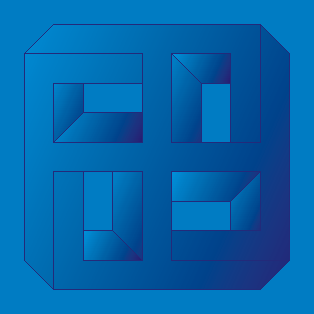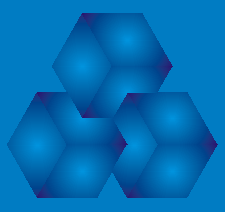

An op-art style artist create pictures of objects doesn't exist in space. This visual effects may be used in publicity as trade marks, ensignes, labeles etc.
All interested
please e-mail: opartist@pisem.net
These trademarks are patented.

OPART IN ADVERTISEMENT
 |
 |
|
An op-art style artist create pictures of objects doesn't exist in space. This visual effects may be used in publicity as trade marks, ensignes, labeles etc. All interested
please e-mail: opartist@pisem.net These trademarks are patented. |
 |
| GUEST BOOK | IMPOSSIBLE WORLD | E-Mail to me |
                           
|
WELCOME TO UNREAL WORLD
"Paint - it means to cheat." M.C. Esher (1898-1972). OP-ART (Op-art - an abridged version of optical art) - Art during the second half of the 20th century, using various visual illusions based on the peculiarities of the perception of planar and spatial figures. The course continues to rationalistic line of techno (modernism). Goes back to the so-called "geometrical" abstract of which was Victor Vazareli (with 1930 to 1997 worked in France), founder of Op Art. Heading of opart (optical art) emerged in the 50-ies within the abstract, although this time some of its varieties - geometric abstraction. His dissemination as course refers to the 60 th of 20 century. The first experiments in the Op-Art are from the end of 19th century. As early as 1889 in the annual "Das neue Universum" appeared article on the optical illusions of German Professor Thompson , who use black and white concentric circles create the impression of motion in the plane: wheel Figures Thompson "spin" and the circles "overflows". But it was a more scientific study of vision than art. In 1955 in Paris opart exhibited in his gallery Denis Rene. But the world-famous opart received in 1965 after New York exhibition "The Responsive Eye" in the Museum of Modern Art. The exhibition «Arte-Fiera-77» held in 1977 in Bologna abundantly demonstrated the work of artists of this trend - Victor Vazareli, Ennio Fintsi and others. Op-art painters are often combined incognito: Group N. (Padua), a group of T. (Milan), the group Zero (Dusseldorf). Group seeking visual arts, led by Victor Vazareli, which provided the initial impetus to the movement of opart. Opart artists used various visual illusions based on the features of the perception of planar and spatial figures. Optical art - the art of optical illusion based on features of visual perception. The perception of the figure is based on an optical illusion: the image does not exist only on canvas, but in reality and in the eyes, and in the spectator head. Optical art is based on visual illusions encountered with the perception of certain configurations in the plane. For example, looking at alternating black and white concentric circles appear to cross beams that rotate like a propeller. Drawing of Cube which marked all his ribs it appears to the eye volatile, and its facets are constantly changing field, putting forward Then back into the depths. When crossing the line segment straight lines may be feeling a broken line. Interpenetration two geometric (eg ring) structure gives the effect of waves. The bright and sharply defined shape provoking the so-called consistent manner, that is, illusory form of the same configuration and Contrasting color. Optical illusion helps to find some regularities visual perception, so they paid close attention to psychologists. A panel of visual tests were experimental. In the perception of real objects illusions arise rare. Therefore, in order to reveal the hidden mechanisms of human perception, it was necessary to put the eye to the unusual conditions that make it atypical solve the problem. Experienced graphic designs created by, for example, School geshtaltpsihologii, led to the formulation of some rules that the process of visual perception going. The artists took advantage of these discoveries on their own. The task of op art - to deceive the eye, to provoke him to a false response, cause the image of «non-existent». Visually conflicting configuration create an irresolvable conflict between the actual shape and visible form. Research of psychologists have shown, for example, that the eyes are always striving to randomly scattered spots in a simple system (Gestalt). In optical art, by contrast, the same simple elements arranged so that disorient the eye to prevent formation of Coherent structure. Thus, the picture of Victor Vazareli «Tau zeta» (1964), squares and diamonds continually rebuilt along the lines of Greek letters, but did not come together in a configuration. In another work of Vazareli-«Supernovae» (1959-1961)-two identical contrast forms create a feeling of moving the flash on the surface mesh after a while separated and freezes, as inscribed in the squares circles disappear and reappear in different locations. The plane is continuously pulses, the permit instant illusion, then again close in Continuous structure. Title of the picture refers to the submission of explosions and the origin of supernovae cosmic energy. Continuously oscillating surface "super sensor" paintings Turns perception to a standstill, causing a visual shock. Especially strong subjected to shock the nervous apparatus of the audience at those shows, which exhibited moving, shining, reflecting light and flare system. Their visitors reacted to the "artistic illusion" dizziness and fainting. Here we should bear in mind one pattern in the evolution of modernism. Consistently refusing the highest means of artistic idealization and imaginative implementation of the material (the ideological content, narrative or allegorical subjects, the image itself, finally) avant-garde directions both lower and level of audience reactions. Thus, in the perception of geometric painting abstraction (in other terminology, "concrete art") is involved only of the formal visual order. Proceeding from these "mathematical" principles, a new generation rejected the specifics and shape. A prominent representative of oparta Jesús Rafael Soto, fond previously neoplastitsizmom Mondrian, said: "I do not accept the word" plastic ". I've always been against "Neoplastic" art, and I know that he Mondrian was of the same opinion. The plastic assumes the shape. But I am against the form. I never believed in the existence of Plastic relationships between forms "(cited by Barret C. Op art.New York, 1970, p.151). This op-art collided with primary, grassroots schemes in the mechanism of human perception. Forced response of the eye to unnatural Gestalt reflex, as a reaction to the finger burns. The conscious interpretation is excluded. The illusion arises automatically as a result of malfunction visual apparatus. Most prominent representative of this trend and theorist Vasarely wrote: "We focus not on the heart, and retina; sophisticated data subjects included in the psychological experiment. Dramatic black-and-white contrasts, unbearable vibration complementary colors, flickering rhythmic grids and changing patterns, optical kinetizm plastic components - all physical phenomena is present in our work; now their role is not to create miracle, do not immerse us in the sweet melancholy, and stimulate, excite In our wild joy "(Ibid., pp. 148). "Groupe of studies of visual art" (a union of artists of the optical and kinetic art) wrote in his manifesto "Enough of mystification" (1961): Should no longer be works exclusively for: cultural eye sensitive eyes intelligent eyes estetskih eyes amateur eye. The human eye is our starting point (ibid., pp. 104). Under the "human eye" refers to the typical reaction of the psyche, on the basis of which there are an illusion. Such illusions do have universal and independent of individual consciousness, culture, beliefs and tastes of the individual. In this sense, the creationы of op-art are public. In addition, many works in this direction due to elementary forms and inexpensive materials (paper, various kinds plastics) can be easily replicated in the industry. On these grounds artists were proud of their democracy of art. So, Vasarely wrote: "My goal is to introduce a plastic awareness into everyday life. My work is offering social welfare par excellence "(Ibid., p.108). Opart representatives argued that their work encourages the viewer to the active complicity in the creation, because the eye itself generates form transforms the "matter" painting in the "energy" of the visible image (See the judgments H.-R. Soto: ibid, p.103). In this op-art merges with massive art: Convergence with forms of mass shows and attractions especially apparent in the spatial op-art designs: rotary, sparkling, constantly changing its appearance systems, moving and shimmering planes and volumes. Findings in this area of Yaacov Agam, Jesus-Rafael Soto, Carlos Cruz-Diez, Julio Le Parc, Joel Sten, Jeffrey Steele and others subsequently successfully used in the design of a discotheques, commercial exhibitions, light and vocal shows and other mass events. Objects in reality can move by using mechanical force or without her. Mobile moving without the mechanical power were invented by Alexander Rodchenko and by few years upgraded Americans A. Calder. His sculptures represent the abstract compositions that move through fluctuations in the air. I. De Soto was interested in optical effects. In his works such EFFECTS obtained by applying one layer to another. For example: two figures in the organic glass with a gap between them. It seems that they merge into a new space. Later Soto began experiment with the lines spread out between screens. Vasarely was the most prominent representative of opart due to both scale their creativity and logical completeness of his method. He investigated the impact of this art and its application in architecture and design that led to the flourishing of op-art in advertising and design to such an extent that even had danger of turning it into an applied art. To achieve external optical effects artists use materials not related to painting (Metal, glass, plastic) but having a reflective surface. The same goal cleaned up Artists on the idea of using the expressive possibilities of fabric and transparent materials - favorite method of advertising and printing shocking and achieves immediate result. In the same spirit will work the generation artists born between 1925 and 1930 whose work is related mainly from 1960s - they systematize previous discoveries and multiply the field of application of opart in everyday life. Starting with the optical effects on the picture plane, they will seek to systematize their composite solutions (Debur Garcia-Rossi, Sobrino Le Parc, DeMarco Morellet) and achieve a shimmering effect (Morellet, Soto, Stein), some of them turned his quest toward Kineticism (Agam Cruz, Diaz Soto, Ivaral Vardanega, Marta Botho). Op-art gradually acquires the international character, in different countries formed the whole groups of artists: in Italy (Alviani De Vecchi, Colombo Marie), Spain (Duarte Ibarrola), Germany (Hacker Mack Gravenitz) Switzerland (Thalmann Gerstner), Soviet Union (Vyacheslav Koleichuk). Note that in the United States crisis of abstraction generates hard-edge and minimalism have been caused by the same esthetic needs. These movements belonged to the tradition of the Bauhaus and Mondrian. Creativity of Joseph Albers who studied at the Bauhaus and moved to The United States will be the basis of this phenomenon. Works of E. Kelly and K. Noland are near op-art in that they introduce an indispensable attribute of American art - giantism. In the same direction has developed sculpture of Tony Smith, Don Judd and Robert Morris. But soon all these artists felt a need to "hole" that opens into the external Space: Cruz Dias experiments with color effects and achieves their "uniform saturation", Soto seeks it to deepen and Agam - to reach their relief. So willingly or unwillingly and perhaps through their own discoveries op-art invisibly united with Kineticism. The possibilities of op-art find some use in Industrial graphics, posters, decoration art. IMPOSSIBLE ART - НЕВОЗМОЖНОЕ ИСКУССТВО Самостоятельным направлением в опарте является т.н. имп-арт (imp-art), использующее для достижения оптических иллюзий особенности отображения трёхмерных объектов на плоскости. Здесь мы видим изображения объектов, не существующих в пространстве - элементы изображения трехмерного объекта расположены во взаимосвязи, препятствующей их однозначному восприятию. Подобные невозможные фигуры прекрасно демонстрируют особенности нашей перцепции пространства. Ведь любая картина в сущности представляет собой набор линий и цветовых пятен, расположенных на п л о с к о с т и! От художника требуется определённое мастерство, чтобы убедить зрителя в наличии объёма, перспективы, создать иллюзию пространства в своём произведении. "Рисовать - значит обманывать." Эти слова М.К.Эшера исполнены глубокого смысла. Невозможные фигуры дают почувствовать масштабы этого обмана. Наиболее известными представителями этого направления являются Оскар Раутесворд, М.К. Эшер(отдельные работы), Жос де Мей, Тамаш Фаркаш, Сандро Дель Пре, Семён Пучков. Первым в ряду невозможных фигур стоит так называемый треугольник Пенроуза - парадоксальный объект, положивший начало целому отряду невозможных объектов, представляющих собой замкнутые конструкции, состоящие из одинаковых элементов , связанных в целое (3,4 и многоугольники каждый из следующий 3х мерный угол которых повёрнут относительно предыдущего на равное к-во градусов). Наиболее яркий представитель этого направления - О.Раутесворд. Далее можно выделить объекты, в которых используется перемена заднего и переднего плана, т.е. элемент заднего плана рисуется поверх элемента переднего плана в месте их пересечения на оси зрения, а по бокам от пересечения они как бы встают на место(это невозможный куб и напр. ещё моя кажется первая работа - решетка ). Дальше трюки с перспективой. Здесь непревзойдённым мастером является Жос де Мей. Добавить сюда нужно ещё невозможные группы возможных 3х мерных фигур, например, нижние фигуры: 4 кубика и 4 пирамидки , поставленные в невозможное взаиморасположение.
Здесь представлены мои работы, опубликованные в каталогах выставок
"ЗНАК-2001" и "ЗНАК-2002", "Знак 2003", "Знак 2004", "Знак 2005", проходивших
в Санкт-Петербурге в ЦВЗ "Манеж", разработанные и
зарегистрированные мной товарные знаки и работы, опубликованные в
журнале "Знание-сила" № 4 за 1985г., в каталоге издательства "Индекс-дизайн" "Знаки, логотипы 2004г." и в каталоге пятой и шестой Всероссийской выставки-конкурса товарных знаков "ЗОЛОТАЯ БЛОХА" Союза дизайнеров России 2004 и 2005 года.
WELCOME TO UNREAL WORLD An op-art style artist create pictures of object does not
exist in space. |
Copyright © 1985-2011, AIA Inc.